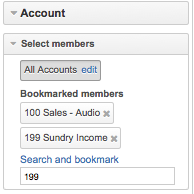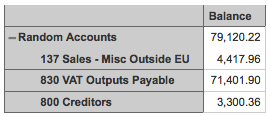...
To re-create your profit & loss report in flex.bi you must follow these instructions.
1. Finding out what your HansaWorld Profit & Loss report contains
To first thing you need to do is find out what your Profit & Loss report is made out of. To do that you have to look at the Report Settings in HansaWorld. To do that:
...
- As well as these can be Sum of Accounts
| Note |
|---|
...
| Important : In HansaWorld reports lines can not be defined by Object limitations - In Flex.bi can |
2. Re-creating the account groups in flex.bi
To recreate your account groups in flex.bi you will need to create Calculated members that aggregate the accounts you need into groups. First you have to pick a group you want to re-create, always try to work with one group at a time to make this task easier. By default you will have the groups Asset, Liability, Equity, Income and Expense created for you already. This example will contain several methods of aggregating accounts into groups:
...
Upload all of the data needed for the financials cube as described here.
Navigate to the financials cube in flex.bi and start creating a new report. Place the Account dimension in the Rows section and the Measures in the Columns section. You should see something similar to this.
If you have any questions about this part please read about Basic concepts of Flex.bi and Report Creating Manual.
Selecting members: In the accounts dimension under Select members click on Search and bookmark, a text input window should open. In that window enter the account number of the account that is the beginning of the interval (in this case 100).
...
You should see an account appear in a list, press enter or click on the account that matches the number to create a bookmark (Visible in the image below). You must do the same for the end account of the interval (in this case account 199)
Creating Calculated member with aggregate function :
Formula : Aggregate ( { first member : last member } )
Now you will have to create a calculated member, calculated members are explained in detail here.
...
You should see the following result.
2. Defining SUM of Accounts or Account
...
Groups
Option
...
1:
...
Formula: Aggregate( {member, member } )
This example will show you how to aggregate three accounts using the sum method ( "+" symbol). When making the calculated member you have to remember that the "+" symbol will have to be replaced with a "," symbol.
...
You should see the following result.
Option
...
2:
...
Formula: SUM( member, member )
Option 3: Formula: member + member + member
3. Limiting results by Object
Option 1 1: Object dimension in pages
Option 2: Include object filter in Calculated member f account Group
This example will show you how to only return the data of accounts that are connected to a certain object. In this example the values of the 3 Random Accounts created in the previous example will be filtered and aggregated into a single member AUDIO - Accounts. This member will return the account values that are connected to the object AUDIO - Audio Products.
...




